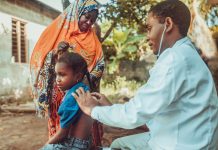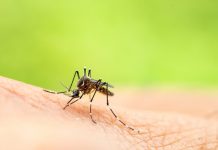Tuberculosis is the second most infectious deadly disease after COVID-19, so why has it been met with political inertia? Vinny Wooding, Senior Parliamentary Advocacy Officer at RESULTS UK, discusses the burden of TB and the rapid action needed to address this global threat
Tuberculosis (TB) is both preventable and curable, yet each year over a million and a half people die needlessly from the tuberculosis pandemic, including 350,000 children. (1) The infecting bacterium, Mycobacterium tuberculosis, is one of humanity’s oldest bacteria, with a history spanning five thousand years.
TB can be either active or passive: 90% of people with TB have inactive, or latent, TB. These people are asymptomatic and are unable to transmit TB. On the other hand, active TB is spread from one person to another through airborne droplets and can affect all parts of the body, most commonly the lungs. Immunocompromised individuals are at a greater risk of contracting active TB, and social factors play a large role in transmitting and treating the disease.
A failure to properly invest in TB means that even after five millennia, global health actors have yet to effectively find, diagnose, treat, and ultimately prevent deaths from the tuberculosis pandemic.
The fight to eradicate the tuberculosis pandemic is replete with roadblocks In 2022, the number of recorded deaths from tuberculosis rose, ending a decade-long streak of decline. (1)
The funding required to finance TB diagnosis, prevention and treatment is short by $7.5 billion, whilst research and development (R&D) funding for TB falls short by $1.1 billion. 48% of people who contract TB will face catastrophic financial costs associated with loss of income, treatment costs and other hardships. (1)
Compounding this, research into new tools and treatments is slow due to the complex nature of the TB bacterium and lack of financing. We cannot solve the tuberculosis pandemic overnight, yet there are concrete actions we can take now to accelerate progress towards eradicating TB by the end of 2030, in line with SDG 3.3.2.
Lessons from the COVID-19 pandemic in response to TB
COVID-19 has shown the world how an airborne respiratory virus can threaten human health and security on a global level in a very short space of time. TB can potentially cause another global epidemic as the bacteria is quickly evolving resistance to modern drugs and medicines.
Drug-resistant TB cannot be cured with regular TB medication and requires a strong cocktail of drugs taken for a prolonged period of time, with extremely toxic side effects to the individual. Drug-resistant TB accounts for a third of all global deaths related to antimicrobial resistance (AMR). (2) Drug-resistant TB is not only a threat to the global spread of AMR but also to the ability of global health systems to respond to future pandemics.
Perhaps the best thing to help drive down tuberculosis levels would be a novel, effective and resilient vaccine that prevents an individual from ever contracting TB.
One TB vaccine already exists – the Bacillus Calmette–Guérin vaccine (BCG), but this is over 100 years old. Clinical trials for vaccines were developed long after the discovery of the BCG vaccine, yet it is still the most widely used TB vaccine in the world.
Vaccine candidates and their shortfalls
Unfortunately, it is also not very effective: the BCG has only 37% efficacy amongst children under five. (3) There is little evidence to suggest that the BCG has any efficacy in adults. (4) The lack of an effective TB vaccine costs millions of lives yearly. The international community needs to do more to drive R&D to discover new tools to fight against the TB bacterium.
There are several promising vaccine candidates in the pipeline at the moment against tuberculosis. Six potential vaccine candidates are in Phase 3 of the clinical development process – the final phase before the vaccine can be regulated for public use. Yet promising vaccine candidates have emerged before and have ultimately fallen short.
Stakeholders within the global TB community wait with bated breath for updates on the progress of these six vaccine candidates. However, we need to be prepared if all six candidates fail – and this requires significantly more finance for further R&D from Nation States and other international actors.
The 2018 UN High-Level Meeting (HLM) on TB set a target of $2 billion per year for R&D into new vaccines, surveillance tools, treatments, and preventative measures. Yet, in 2022, only $900 million was forthcoming from donors. (1)
We need to find innovative and novel ways of raising finance to support TB R&D, and the 2023 HLM provides just that opportunity. Additionally, we need to accelerate political leadership and engagement with the tuberculosis pandemic.
The tuberculosis pandemic is just as much political as it is infectious
A transformational leadership approach is needed now more than ever in an increasingly unpredictable and volatile world. All countries have a responsibility to invest in health systems to protect people, societies, the economy, and the planet from the tuberculosis pandemic.
As the old adage goes: ‘no one is safe, until everyone is safe.’
COVID-19 exposed and magnified the weaknesses and inequality within global health systems. To end the tuberculosis pandemic, we must strengthen health systems to be resilient, gender-responsive, and community-led, with an empowered workforce that can meet the needs of the most marginalised in society.
Proactive policy frameworks are required to target the most vulnerable and marginalised groups by addressing the social, economic, and cultural determinants driving TB. These policies require a multi-sectoral approach with collaboration across stakeholders and sectors to end TB and ensure no one is left behind.
The 2023 UN High-Level Meeting on TB will take place in September. It presents a perfect opportunity for Heads of State and governments to step up to the challenge and show what global health solidarity means.
The cost of investing proactively to end TB far outweighs the cost of treating TB and its related consequences; we can reduce this further with countries working together to share resources, knowledge, and best practice. Evidence suggests that for every $1 spent investing in TB, $34 of economic benefit is gained (5), highlighting again the benefits and imperatives of proactively tackling TB before it becomes active. The urgent need to end the tuberculosis pandemic is more than a health issue; it is imperative to protect our societies, health systems and the global economy for the future.
How can any political leader or country not afford to invest in this?
References
- https://www.who.int/teams/global-tuberculosis-programme/tb-reports/global-tuberculosis-report-2022
- TB Alliance https://www.tballiance.org/sites/default/files/assets/DR-TB_Factsheet.pdf
- McKoy, Gillian (2022), ‘BCG Vaccine Prevents Tuberculosis in Young Children, but Not Adults’. Boston University School of Public Health
- Hatherill, Mark & Cobelens (2022) ‘Infant BCG vaccination is beneficial, but not sufficient’. The Lancet
- WHO (2022) https://www.who.int/publications/i/item/9789240064690
Contributor Details
Editor's Recommended Articles
-
Must Read >> Tuberculosis drug regimens and their efficacies












Unless we start telling our medical professionals that TB still exists then more people will die! The public have no idea that TB is here our GPs have no idea it’s heat – so who’s telling them??????